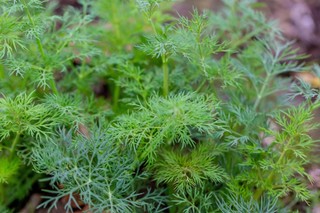How to grow dill indoors

The intense flavor of dill(Anethum graveolens) has propelled it into an important culinary resource with its seeds and leaves—known as dill weed—used in many dishes, especially Mediterranean cuisine.
Whether you’re looking to turn cucumbers into dill pickles, bake delicious breads, or create hearty soups or stews, having fresh dill on hand is always better than opting for dried dill from the market.
These undemanding plants are now commonly grown in vegetable gardens and indoor herb gardens to provide fresh herbs on demand.
To grow dill indoors, sow seeds in a deep, unglazed terra cotta container filled with potting soil or coconut coir. For optimum growth, plants need a minimum of 6 hours of direct sunlight daily and temperatures between 65 - 75°F.

Growing supplies
Like most other herbs, growing dill indoors is easy, straightforward, and requires no special equipment.
Things to keep in mind when planting:
- Use appropriately sized containers.
- Find high-quality potting soil that fits your needs.
- Make sure your chosen seed variety works well for indoor gardening.
Containers
Dill produces a long taproot to anchor itself into the soil. To accommodate for root growth, choose containers at least 12” deep and a minimum of 6-8” in diameter. If your container does not have sufficient drainage holes in the bottom, use a drill (or similar tool) to create some, to allow excess water to drain from the potting soil.
For deep roots like this, we opt for the 12” clay pot with a saucer. You can buy it from Amazon here.
If you’re unsure how to choose the best pot for container gardening, read our helpful guide here.
Growing media
Coconut coir and rich soil are two of the most common options for indoor gardening. They are both lightweight with good water and nutrient holding capacity.
- Coconut coir is well-draining but has excellent water retention capabilities, holding approximately 8-10 times its weight in water. It is composed of the brown and white fibers found between the shell and the outer coating of a coconut seed and is popular in hydroponics and indoor gardening.
- Potting soil is a combination of “soilless” materials made with peat moss or coconut coir, pine bark, perlite, and vermiculite.
If you’re looking to save time, our go-to potting soil is made by Fox Farm. Read reviews and purchase Fox Farm soil here on Amazon.
For more information on growing media, check out our complete soil guide here.
Seeds
Dill grows best when planted from seed versus trying to transplant purchased plants into containers. Seeds are available for purchase in a handful of varieties, each with characteristics setting them apart from one another.
- Bouquet is the most commonly grown type of dill and is used extensively for pickling, although it works well in any recipe calling for either dill leaves or seeds.
- Fernleaf and Dukat are compact/dwarf varieties, reaching heights of 18” and 3’ respectively; they are both popular for growing dill in containers.

Planting instructions for full-sized plants
Dill does best when planted in containers during cooler temperatures, even when grown indoors. Planting dill in October through early spring typically brings ideal germination and plant growth.
- Fill chosen containers with pre-moistened potting soil, tamping it down slightly to remove any large air pockets. This prevents the potting soil from settling over time.
- Scatter seeds across the top of the potting soil and then cover with a small amount of potting soil, or sow them directly into the soil no more than ¼” deep. Maintain a minimum of 4” spacing between the seeds.
- Keep the potting soil slightly damp by misting it with a spray bottle and place it in a location where the container won’t be disturbed until the seeds germinate.
- After plants germinate and reach a couple of inches tall, thin seedlings to 9-12” apart. Each dill plant produces substantial leaves and seeds; 1-2 plants per household is sufficient in most cases.
Growing dill as a microgreen
Even the best gardeners struggle at times with poor plant growth or plants that won’t thrive. In this case, it’s beneficial to try growing dill indoors as a microgreen.
- Fill a small tray (4x4 or 5x5” at most) with pre-soaked coconut coir.
- Scatter 1-2 teaspoons of unsoaked dill seeds across the top of the growing media.
- Gently press the seeds into the soil without covering them.
- Mist with a spray bottle.
- Place the tray in an area where the temperature is 70-72°F. Keep seeds exposed and moist, misting with a spray bottle if any water is needed.
Microgreens should be harvested after the seed sprouts but before the first true leaves form. When grown as a microgreen, dill is ready to harvest about 14 days after germination when it is about 1-2” tall.
To learn all about microgreens and how to grow them, check out our in-depth Microgreens 101 article here.

The enthusiast's guide to herbs
We’re proud to present our new e-book, The Enthusiast’s Guide to Herbs! Learn everything you need to know about growing and caring for herbs indoors, including in-depth info cards for the 35 most commonly grown herbs.
Click the link below to find out more!
Indoor growing conditions
When growing dill indoors, it’s important to provide plants with the appropriate amount of sunlight and the correct ambient temperature. Optimum growing conditions produce strong, vigorous plants and desirable growth.
Sunlight
Dill prefers full sun conditions when grown outside; indoor plants grow best when placed in a location that receives a minimum of 6 hours of direct sunlight.
If you don’t have a window that gets 6 hours of sunlight, provide 12 hours of supplemental lighting with incandescent, fluorescent, or LED grow lights.
If you’re looking for a good supplemental grow light, we recommend this one that you can find on Amazon.
Temperature
Dill is classified as a cool-season herb and needs ambient temperatures above 60°F to grow, preferring a range between 65 - 75°F.
Avoid placing containers too close to windows due to cold air, and anywhere else they are exposed to drafts from doors or register vents. The extreme temperature variations cause internal stresses classified as chilling stress (occurring at temperatures below freezing), freezing stress (occurring at low temperatures above freezing), or high-temperature stress [1], all of which hinder plant growth and yields.
How to care for your dill

Dill is an easy-to-grow plant, providing mature, harvestable plants in a relatively short amount of time. Basic care for plants mimics the management of most other herbs.
- Allow the soil to dry out to the depth of 1 - 2” and then water until the soil is thoroughly moistened and excess water drains from the bottom of the pot. An easy way to check soil moisture is to stick your finger down into the potting soil to see how dry it is. Dill does not want its soil moist all of the time.
- Dill plants don’t need a heavy dose of fertilizer as this affects the flavor of the leaves and seeds. Apply fertilizer at half strength every 4-6 weeks when dill is grown indoors.
- Stake plants to provide additional support when they get taller to keep them from slumping or falling over. You can also pinch off the tops of the plants to encourage them to grow outward instead of upward, creating bushier plants. [2]
Harvesting dill leaves and seeds
- Harvest dill leaves 6 - 8 weeks after planting seeds once the dill flower heads begin forming.
- Seeds are ready to harvest slightly before they ripen and turn tan in color.
FAQ
Is dill easy to grow in containers?
Dill is very easy to grow in containers, as long as the chosen container is deep enough for the plant’s taproot and the plant gets plenty of sunlight. It needs at least 6 hours of direct sun every day and likes temperatures between 65 and 75F. Water when the top of the soil is dry.
Should I soak dill seeds before planting?
It isn’t necessary to soak dill seeds before planting, but it is helpful for germination because it softens the seed coat. To speed up germination, soak seeds in freshwater for 12 to 24 hours before planting, making sure they soak no more than 48 hours maximum.
How do I dry dill seeds?
Snip the seed heads from the plant and drop them into a paper bag to dry dill seeds. Place the bag in a warm, dry location for a week or more. Avoid high humidity spots or plastic bags since they encourage mildew growth.
Źróbek-Sokolnik, Anna. 2012. “Temperature Stress and Responses of Plants.” In Environmental Adaptations and Stress Tolerance of Plants in the Era of Climate Change, edited by Parvaiz Ahmad and Prasad Majeti Narasimha Vara, 113–34. New York: Springer New York. ↩︎
Mutetwa, M., Eve Beura, Mtaita Tuarira and M. Thomas. 2016. “The influence of pinching on the growth, flowering pattern and yield of butternuts (Cucurbita moschata).” International Journal of Horticulture and Ornamental Plants 2, no. 1 (October): 19-25. ↩︎
